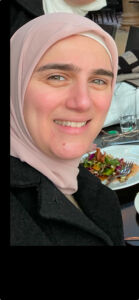 Over the past year, the IRC has asked members of our community to nominate Illinois teachers working with multicultural, multilingual students who are going above and beyond, and now, we’re celebrating them and highlighting their work. Keep an eye out for these features in the coming months – and if you’d like to nominate someone, email leanet@cntrmail.org. Next up is Neda Sunbulli, a Bilingual First Grade teacher at North Palos District 11.
Over the past year, the IRC has asked members of our community to nominate Illinois teachers working with multicultural, multilingual students who are going above and beyond, and now, we’re celebrating them and highlighting their work. Keep an eye out for these features in the coming months – and if you’d like to nominate someone, email leanet@cntrmail.org. Next up is Neda Sunbulli, a Bilingual First Grade teacher at North Palos District 11.
Says Barbara Dziatkowiec, who nominated her: “Mrs. Sunbulli’s classroom is a place where every child’s voice is celebrated. She understands that her English Language Learners arrive with a wealth of knowledge and experiences and is passionate about nurturing their linguistic growth. With a heart full of compassion, she employs a variety of strategies to build their foundational skills, vocabulary and confidence. She celebrates each milestone and the small wins. She is dedicated to empowering her students by developing the language skills they need to be successful lifelong learners.”
Neda Sunbulli’s multilingual education journey first began halfway around the world, when she began teaching pre-kindergarten at an international school in China. “I taught kids from literally all over the world — Spain, Korea, Italy, France — pretty much the UN,” she says.
From there, she worked for three years teaching an English curriculum to kindergarteners in Damascus, Syria. Now, for nearly a decade, she has taught young multilingual learners at North Palos. “It wasn’t originally my intention, but it unfolded that way, and I grew attached to teaching kids of multilanguage backgrounds,” she says.
Working with a younger student group, some of whom are learning both their heritage language and English, requires intentionality, Sunbulli says. She says she has to think about how she teaches and talks and what the objective is, down to word choice, and how students can get from Point A to Point B to Point C. She’s found that cultural responsiveness and creativity have been particularly helpful with these students. “Words are around them,” she says. “Books, restaurant signs, menus. So I find reaching from their own familiar experiences definitely helps.”
Most of Sunbulli’s students are native Arabic speakers, with many coming from Yemen, Palestine and Jordan. She will often incorporate landscapes, animals and even celebrations or references to folk clothing that reflect the students’ cultural backgrounds. “When I use certain cultural references, it makes them smile,” she says. “Language and culture are so related, so using that I feel really helps.”
She will make students feel at home by greeting them in Arabic, and says that with a majority Muslim student population, there is a sense of recognition that comes from having a teacher who wears a hijab. “I’m lucky that we have certain topics as part of our curriculum so it allows [students] to feel like they’re a part of the learning as well,” she says.
In working with newcomers in particular, Sunbulli has often been a resource for her colleagues, who will ask her questions about the cultures of her new students. “They know there is no question that is offensive as long as you’re asking to learn,” she says.
While there are difficult days at any school, for Sunbulli, those moments of comfort and clarity for a student drive her sense of purpose. “When a newcomer starts to blend sounds and use strategies we’ve learned and they’ve read a sentence, we look at each other and it’s this unspoken kind of communication,” she says. “They’re telling me with their eyes, ‘I did it.’ It makes me feel like that’s why I do this.”
Sunbulli says sometimes newcomers are pigeonholed or perceived as a disruption, and she challenges her fellow educators to take the perspective of being curious about these students and their experiences. She advises her peers working with newcomers to be patient and focus on progress, and above all, ensuring that that student feels supported and welcome at school, “The most important thing is that they want to come to school,” she says. “Just smiling, making them feel at home, pairing a student who is very kind and helpful with a newcomer. If they enjoy and feel comfortable, the skills will come.”


